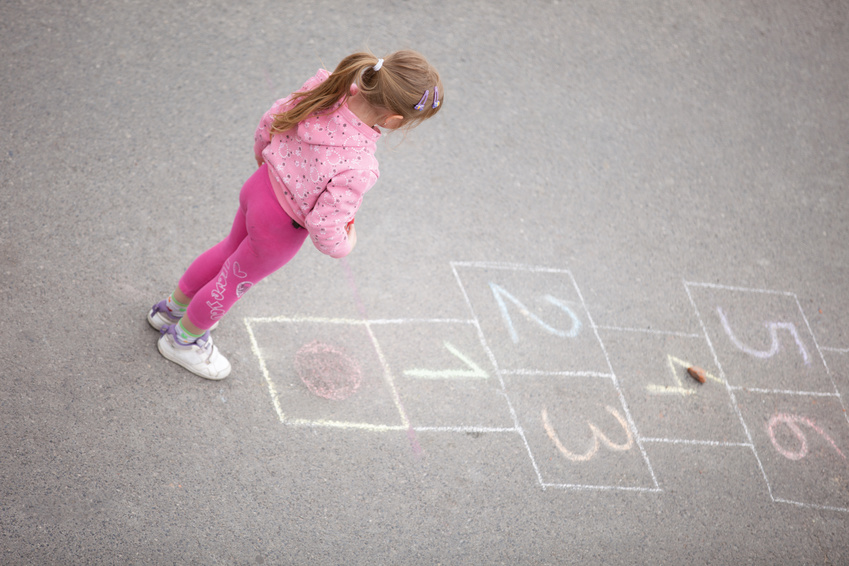This resource explores connections among executive functioning (EF) and geometry and spatial relations and provides tips for early childhood educators to support EF while engaging in and geometry and spatial relations.
by Jane Hutchison & Deborah Phillips
EF and Geometry and Spatial Relations Connections
In the overview module we explain why executive functioning (EF) skills are important for early math learning in general (see Overview of Executive Functioning and Math) and how engaging in math activities can support the development of EF. Here we discuss the role of executive functions in geometry (i.e. the mathematics of shape and space) and spatial relations (i.e. the relationships of shapes/objects in space) specifically. As  mentioned in The Mathematics of Geometry and Spatial Relations, the mathematics of geometry and spatial relations involves an understanding of the basic attributes of shapes and how they can be manipulated and transformed, and the relationships of objects in space. Building this understanding involves a good deal of executive functioning.
mentioned in The Mathematics of Geometry and Spatial Relations, the mathematics of geometry and spatial relations involves an understanding of the basic attributes of shapes and how they can be manipulated and transformed, and the relationships of objects in space. Building this understanding involves a good deal of executive functioning.
- Understanding Basic Attributes of Shape: In preschool, children are often taught, and sometimes create for themselves, a set of rules for classifying different shapes. For example, children typically learn that one of the rules for triangles is that they have three sides, while rectangles have four. While these rules may seem relatively simple, learning the basic attributes of shapes becomes rather complex when children come to realize that not all shapes that fall within the triangle or rectangle family are the same. For example, children typically first learn to apply the name ‘triangle’ to a standard equilateral triangle with three equal sides and the point facing up. When presented with a triangle with the point facing down or unequal sides, children must use their cognitive flexibility skills to compare and contrast the different types of triangles and understand which attributes make them different (i.e. different angles/length of sides) and which attributes allow them to be classified as a triangle (i.e., a closed figure with three sides).
- Transformations of Shapes in Space: Once children have acquired the basic attributes of shapes, they can then learn to transform them in various ways. Transformation occurs when children, for example, create a new shape by putting two existing shapes together (e.g. putting two right triangles together to form a rectangle) or decompose an existing shape to form two new shapes (e.g. cutting a rhombus into two triangles). The ability to transform shapes involves the use of multiple EF skills. For example, if asked to fold a rectangle to make two triangles, the child must first remember what makes up a triangle in order to set the end goal (planning and organization) and then shift their focus from the rectangle as whole to its constituent parts (cognitive flexibility).
- Relationships of Objects in Space: Children use executive functioning all the time in navigating their environments. Playing hide-and-seek requires children to inhibit looking in hiding places already searched, working memory assists in remembering which objects were incorrect answers in I Spy, and cognitive flexibility is needed when inserting a cylinder and then a cube into a shape sorter.
The examples above demonstrate how geometry and spatial relations are complex skills that call upon multiple EF abilities. As a result, early childhood educators should think of geometry and spatial reasoning activities as opportunities not only to support the development of important mathematical skills but also as opportunities to practice and develop EF skills.
Incorporating EF Support into Geometry and Spatial Relations: Tips for Early Childhood Educators
Below we offer some tips for how early childhood educators can incorporate more explicit EF support into activities involving shapes and spatial thinking.
Working Memory: Students practice WM skills when they are required to hold and/or manipulate multiple pieces of information in mind over short periods of time. This information is then used to solve a problem. Games involving shapes and spatial thinking offer many opportunities for teachers to support WM skills. For example:
- Teachers may ask their students to form mental transformations of shape. For instance, the teacher may ask “If you put two triangles together, what shape could you make?” Asking children to transform shapes mentally, rather than physically, calls upon working memory skills as the child must hold multiple pieces of information in mind at once (namely different orientations of how two triangles can be manipulated and combined).
- Teachers can also play “shape naming” games, where they ask their students to name the shape based on a list of attributes. For example, the teacher may say “I am thinking of a shape that has three sides and three angles. What shape am I thinking of?” These types of questions call upon children’s working memory skills as they require them to hold multiple attributes in mind and match them with what they know about shapes in order to come up the correct answer.
 Inhibitory Control: Students practice inhibitory control skills when they engage in activities that require them to wait their turn and/or think before they act. For example:
Inhibitory Control: Students practice inhibitory control skills when they engage in activities that require them to wait their turn and/or think before they act. For example:
- When playing with a shape bingo game where children use a roll of the dice to determine if they have a shape that has the same number of sides as pips on the die, children wait their turn as everyone gets a turn to roll the die.
- Hopscotch is a game that requires children to inhibit hopping in a specific square, skipping the square with a marker in it. Children use spatial relation skills to identify where they need to hop over the square.
Cognitive Flexibility: Teachers can support cognitive flexibility by encouraging students to make comparisons, shift perspectives and to approach activities in different ways. For example:
- Teachers may ask children questions that require them to compare and contrast different shapes. For example, when shown three different triangles (e.g. equilateral, isosceles, and right), the teacher may ask “How are these three shapes different and how are they the same?” In this way, the child is thinking flexibly about how triangles can be the same and different at the same time. Note that knowing the name of the type of triangle is not as important at this stage as noticing the differences between them and understanding that they are all triangles regardless of the length of the sides.
- Playing activities that involve the composition and decomposition of shapes rely on cognitive flexibility, insofar as children must shift from focusing on the individual part to the whole (in the case of composition) and from focusing on the whole to the individual (in the case of decomposition). For example, the teacher may ask “What two shapes could you put together to make a house?” or “Can you draw a line through the rectangle to make two triangles?”
Planning and Organization: Students practice their planning and organization skills when they engage in multi-part activities that require the organization of materials and/or adherence to a sequence of steps. For example:
- When playing with Tangrams, the teacher may first ask “What would you like to make?” followed by “Which shapes do you think you’ll need to make that?”
- As children begin a drawing, teachers can ask them to describe what they plan to draw and ask questions about the location of the components (Where are you going to put the house? How about the airplane?).
- When building a puzzle, the teacher may encourage the student to organize the pieces before they begin. The student may choose to separate out the border pieces or organize the pieces by color, for example.
Check out our Executive Functioning and Math resources across our other content modules:
